warning SKODA YETI 2010 1.G / 5L Owner's Manual
[x] Cancel search | Manufacturer: SKODA, Model Year: 2010, Model line: YETI, Model: SKODA YETI 2010 1.G / 5LPages: 271, PDF Size: 14.71 MB
Page 168 of 271
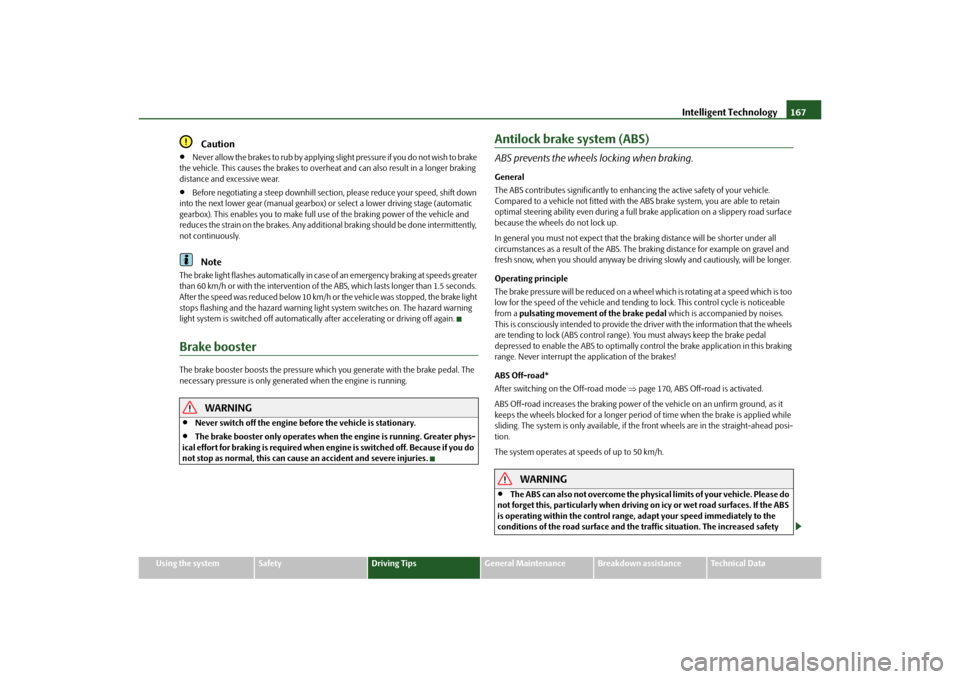
Intelligent Technology167
Using the system
Safety
Driving Tips
General Maintenance
Breakdown assistance
Technical Data
Caution
Never allow the brakes to rub by applying sl ight pressure if you do not wish to brake
the vehicle. This causes the br akes to overheat and can also result in a longer braking
distance and excessive wear.
Before negotiating a steep downhill section, please reduce your speed, shift down
into the next lower gear (manual gearbox) or select a lower driving stage (automatic
gearbox). This enables you to make full us e of the braking power of the vehicle and
reduces the strain on the brakes. Any additional braking should be done intermittently,
not continuously.Note
The brake light flashes automatically in case of an emergency braking at speeds greater
than 60 km/h or with the intervention of the ABS, which lasts longer than 1.5 seconds.
After the speed was reduced below 10 km/h or the vehicle was stopped, the brake light
stops flashing and the hazard warning light system switches on. The hazard warning
light system is switched off automatically after accelerating or driving off again.Brake boosterThe brake booster boosts the pressure which you generate with the brake pedal. The
necessary pressure is only genera ted when the engine is running.
WARNING
Never switch off the engine before the vehicle is stationary.
The brake booster only operates when the engine is running. Greater phys-
ical effort for braking is required when en gine is switched off. Because if you do
not stop as normal, this can cause an accident and severe injuries.
Antilock brake system (ABS)ABS prevents the wheels locking when braking.General
The ABS contributes significantly to enhanc ing the active safety of your vehicle.
Compared to a vehicle not fitted with the ABS brake system, you are able to retain
optimal steering ability even during a full br ake application on a slippery road surface
because the wheels do not lock up.
In general you must not expect that the braking distance will be shorter under all
circumstances as a result of the ABS. The braking distance for example on gravel and
fresh snow, when you should anyway be driv ing slowly and cautiously, will be longer.
Operating principle
The brake pressure will be reduced on a wheel which is rotating at a speed which is too
low for the speed of the vehicle and tending to lock. This control cycle is noticeable
from a pulsating movement of the brake pedal which is accompanied by noises.
This is consciously intended to provide the driver with the information that the wheels
are tending to lock (ABS control range). You must always keep the brake pedal
depressed to enable the ABS to optimally control the brake application in this braking
range. Never interrupt the application of the brakes!
ABS Off-road*
After switching on the Off-road mode page 170, ABS Off-road is activated.
ABS Off-road increases the braking power of the vehicle on an unfirm ground, as it
keeps the wheels blocked for a longer period of time when the brake is applied while
sliding. The system is only available, if the front wheels are in the straight-ahead posi-
tion.
The system operates at speeds of up to 50 km/h.
WARNING
The ABS can also not overcome the physical limits of your vehicle. Please do
not forget this, particularly when driving on icy or wet road surfaces. If the ABS
is operating within the control range, adapt your speed immediately to the
conditions of the road surface and the traffic situation. The increased safety
s2ug.6.book Page 167 Friday, April 9, 2010 2:24 PM
Page 169 of 271
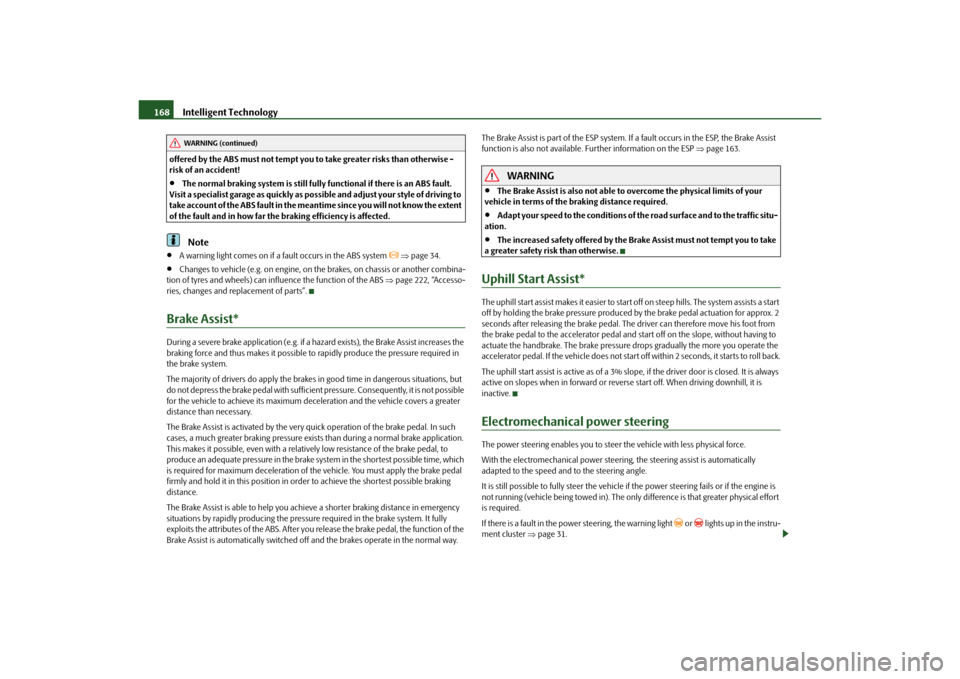
Intelligent Technology
168
offered by the ABS must not tempt you to take greater risks than otherwise -
risk of an accident!
The normal braking system is still fully functional if there is an ABS fault.
Visit a specialist garage as quickly as poss ible and adjust your style of driving to
take account of the ABS fault in the meantime since you will not know the extent
of the fault and in how far the braking efficiency is affected.Note
A warning light comes on if a fault occurs in the ABS system
page 34.
Changes to vehicle (e.g. on engine, on th e brakes, on chassis or another combina-
tion of tyres and wheels) can in fluence the function of the ABS page 222, “Accesso-
ries, changes and replacement of parts”.
Brake Assist*During a severe brake application (e.g. if a hazard exists), the Brake Assist increases the
braking force and thus makes it possible to rapidly produce the pressure required in
the brake system.
The majority of drivers do apply the brakes in good time in dangerous situations, but
do not depress the brake pedal with sufficient pressure. Consequently, it is not possible
for the vehicle to achieve its maximum deceleration and the vehicle covers a greater
distance than necessary.
The Brake Assist is activated by the very quick operation of the brake pedal. In such
cases, a much greater braking pressure exists than during a normal brake application.
This makes it possible, even with a relative ly low resistance of the brake pedal, to
produce an adequate pressure in the brake system in the shortest possible time, which
is required for maximum deceleration of th e vehicle. You must apply the brake pedal
firmly and hold it in this position in order to achieve the shortest possible braking
distance.
The Brake Assist is able to help you achieve a shorter braking distance in emergency
situations by rapidly producing the pressure required in the brake system. It fully
exploits the attributes of the ABS. After you release the brake pedal, the function of the
Brake Assist is automatically switched off and the brakes operate in the normal way. The Brake Assist is part of the ESP system. If a fault occurs in the ESP, the Brake Assist
function is also not available.
Further information on the ESP page 163.
WARNING
The Brake Assist is also not able to overcome the physical limits of your
vehicle in terms of the braking distance required.
Adapt your speed to the conditions of th e road surface and to the traffic situ-
ation.
The increased safety offered by the Brake Assist must not tempt you to take
a greater safety risk than otherwise.
Uphill Start Assist*The uphill start assist makes it easier to start off on steep hills. The system assists a start
off by holding the brake pressure produced by the brake pedal actuation for approx. 2
seconds after releasing the brake pedal. The driver can therefore move his foot from
the brake pedal to the accelerator pedal and start off on the slope, without having to
actuate the handbrake. The brake pressure drops gradually the more you operate the
accelerator pedal. If the vehicle does not start off within 2 seconds, it starts to roll back.
The uphill start assist is active as of a 3% slope, if the driver door is closed. It is always
active on slopes when in forward or reverse start off. When driving downhill, it is
inactive.Electromechanical power steeringThe power steering enables you to steer the vehicle with less physical force.
With the electromechanical power steering, the steering assist is automatically
adapted to the speed and to the steering angle.
It is still possible to fully steer the vehicle if the power steering fails or if the engine is
not running (vehicle being towed in). The only difference is that greater physical effort
is required.
If there is a fault in the power steering, the warning light
or lights up in the instru-
ment cluster page 31.
WARNING (continued)
s2ug.6.book Page 168 Friday, April 9, 2010 2:24 PM
Page 170 of 271

Intelligent Technology169
Using the system
Safety
Driving Tips
General Maintenance
Breakdown assistance
Technical Data
WARNING
Contact your specialist garage if the power steering is defective.Tyre pressure monitoring system*The tyre pressure monitoring system compares with the aid of the ABS sensors the
speed and also the rolling circumference of the individual wheels. If the rolling circum-
ference of a wheel is changed, the warning light
lights up in the instrument cluster
page 34 and an audible sign al sounds. The rolling circumference of the tyre can
change if:
the tyre inflation pressure is too low,
the structure of the tyre is damaged,
the vehicle is loaded on one side,
the wheels of an axle are loaded heavily (e.g. when towing a trailer or when driving
uphill or downhill),
snow chains are mounted,
the temporary spare wheel is mounted,
one wheel per axle was changed.
Basic setting of the system
After changing the tyre inflation pressures, after changing one or several wheels, the
position of a wheel on the vehicle (e.g. exch anging the wheels between the axles) or when the warning light lights up while drivin
g, a basic setting of the system must be
carried out as follows.
Inflate all tyres to the specified inflation pressure page 216.
Switch on the ignition.
Press button fig. 148 for more than 2 seconds. While pressing the button,
the warning light
lights up. At the same time the memory of the system is erased
and the new calibration is started, which is confirmed with an audible signal and then
the warning light goes out.
If the warning light
does not go out after the basic setting, there is a fault in the
system. Have the vehicle inspected by your nearest specialist garage.
Warning light
lights up
If the tyre inflation pressure of at least one wheel is insufficiently inflated in comparison
to the stored basic va lue, the warning light
lights up.
Warning light
flashes
If the warning light flashes, there is a system fault. Have the vehicle inspected by your
nearest specialist garage.
WARNING
When the warning light
lights up, immediately reduce the speed and
avoid sudden steering and brake manoeuvr es. Please stop the vehicle without
delay at the nearest possible stop and in spect the tyres and their inflation pres-
sures.
The driver is responsible for the correc t tyre inflation pressures. For this
reason, the tyre inflation pressures must be checked regularly.
Under certain circumstances (e.g. sporty style of driving, wintry or unpaved
roads) the warning light
can be delayed or does not light up at all.
The tyre pressure monitoring system do es not take away the responsibility
from the driver for the correct tyre inflation pressure.Note
The tyre pressure monitoring system:
Fig. 148 Button for setting the tyre infla-
tion pressure control value
s2ug.6.book Page 169 Friday, April 9, 2010 2:24 PM
Page 171 of 271
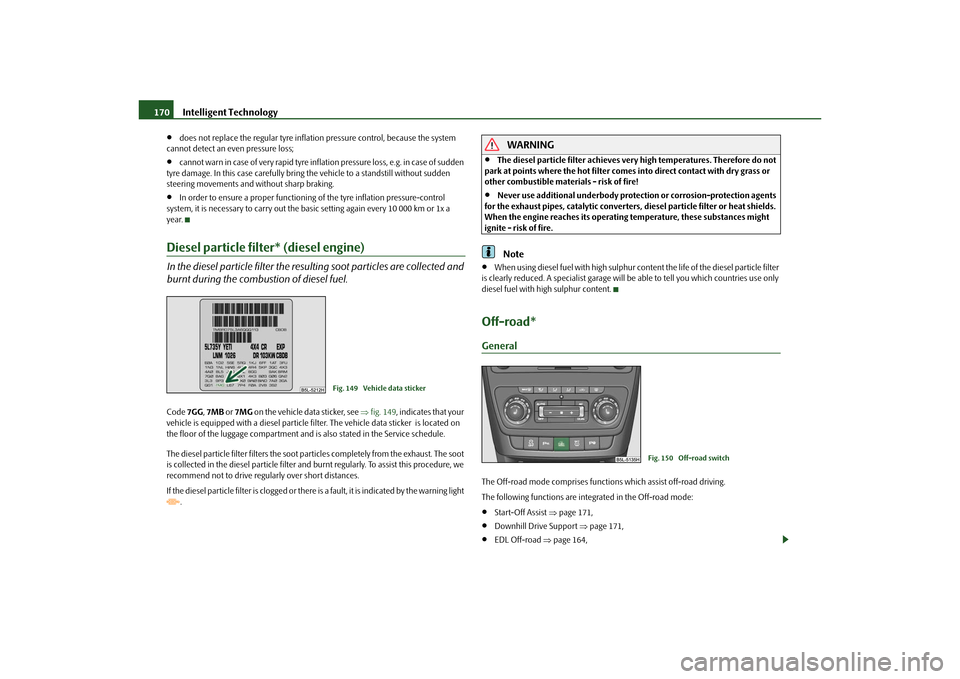
Intelligent Technology
170
does not replace the regular tyre inflatio n pressure control, because the system
cannot detect an even pressure loss;
cannot warn in case of very rapid tyre inflation pressure loss, e.g. in case of sudden
tyre damage. In this case carefully bring the vehicle to a standstill without sudden
steering movements and without sharp braking.
In order to ensure a proper functioning of the tyre inflation pressure-control
system, it is necessary to carry out the basic setting again every 10 000 km or 1x a
year.
Diesel particle filter* (diesel engine)In the diesel particle filter the resu lting soot particles are collected and
burnt during the combustion of diesel fuel.Code 7GG, 7MB or 7MG on the vehicle data sticker, see fig. 149 , indicates that your
vehicle is equipped with a diesel particle filter. The ve hicle data sticker is located on
the floor of the luggage compartment and is also stated in the Service schedule.
The diesel particle filter filters the soot particles completely from the exhaust. The soot
is collected in the diesel particle filter and burnt regularly. To assist this procedure, we
recommend not to drive regu larly over short distances.
If the diesel particle filter is clogged or there is a fault, it is indicated by the warning light
.
WARNING
The diesel particle filter achieves very high temp eratures. Therefore do not
park at points where the hot filter comes into direct contact with dry grass or
other combustible materials - risk of fire!
Never use additional underbody protection or corrosion-protection agents
for the exhaust pipes, catalytic converters, diesel particle filter or heat shields.
When the engine reaches its operating temperature, these substances might
ignite - risk of fire.Note
When using diesel fuel with high sulphur content the life of the diesel particle filter
is clearly reduced. A specialist garage will be able to tell you which countries use only
diesel fuel with high sulphur content.
Off-road*GeneralThe Off-road mode comprises functions which assist off-road driving.
The following functions are integrated in the Off-road mode:
Start-Off Assist page 171,
Downhill Drive Support page 171,
EDL Off-road page 164,
Fig. 149 Vehicle data sticker
Fig. 150 Off-road switch
s2ug.6.book Page 170 Friday, April 9, 2010 2:24 PM
Page 172 of 271
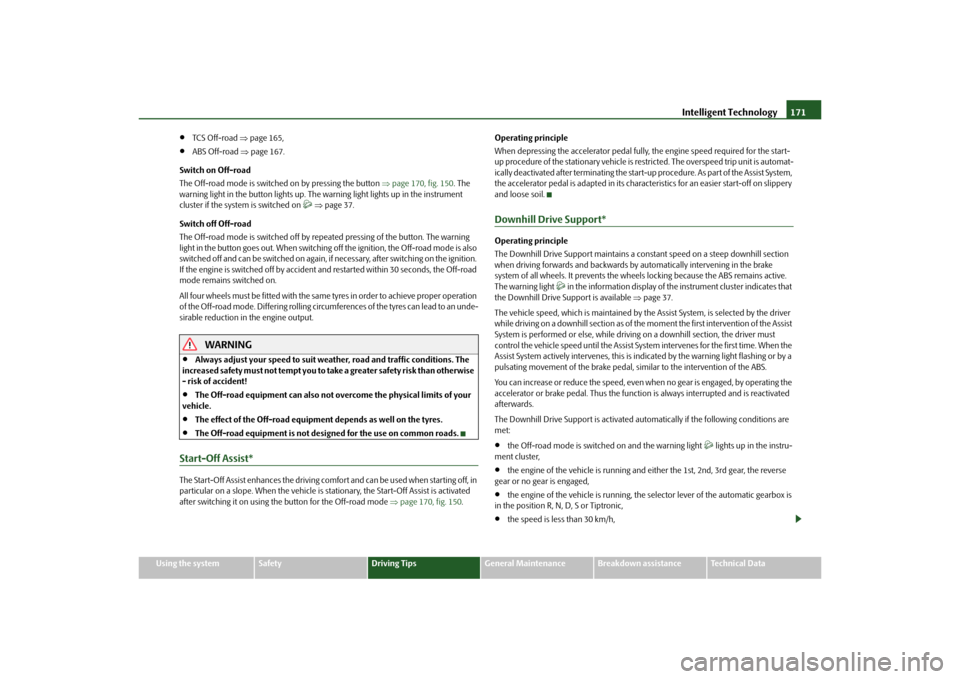
Intelligent Technology171
Using the system
Safety
Driving Tips
General Maintenance
Breakdown assistance
Technical Data
TCS Off-road page 165,
ABS Off-road page 167.
Switch on Off-road
The Off-road mode is switched on by pressing the button page 170, fig. 150 . The
warning light in the button lights up. The warning light lights up in the instrument
cluster if the system is switched on
page 37.
Switch off Off-road
The Off-road mode is switched off by repe ated pressing of the button. The warning
light in the button goes out. When switching off the ignition, the Off-road mode is also
switched off and can be switched on again, if necessary, after switching on the ignition.
If the engine is switched off by accident an d restarted within 30 seconds, the Off-road
mode remains switched on.
All four wheels must be fitted with the same tyres in order to achieve proper operation
of the Off-road mode. Differing rolling circum ferences of the tyres can lead to an unde-
sirable reduction in the engine output.
WARNING
Always adjust your speed to suit weat her, road and traffic conditions. The
increased safety must not tempt you to take a greater safety risk than otherwise
- risk of accident!
The Off-road equipment can also not overcome the physical limits of your
vehicle.
The effect of the Off-road equipment depends as well on the tyres.
The Off-road equipment is not designed for the use on common roads.
Start-Off Assist*The Start-Off Assist enhances the driving comfort and can be used when starting off, in
particular on a slope. When the vehicle is stationary, the Start-Off Assist is activated
after switching it on using the button for the Off-road mode page 170, fig. 150 .Operating principle
When depressing the accelerator pedal fully, the engine speed required for the start-
up procedure of the stationary vehicle is restricted. The overspeed trip unit is automat-
ically deactivated after terminating the start-up procedure. As part of the Assist System,
the accelerator pedal is adapted in its characteristics for an easier start-off on slippery
and loose soil.
Downhill Drive Support*Operating principle
The Downhill Drive Support maintains a cons
tant speed on a steep downhill section
when driving forwards and backwards by automatically intervening in the brake
system of all wheels. It prevents the wheels locking because the ABS remains active.
The warning light
in the information display of the instrument cluster indicates that
the Downhill Drive Support is available page 37.
The vehicle speed, which is maintained by the Assist System, is selected by the driver
while driving on a downhill section as of the moment the first intervention of the Assist
System is performed or else, while driving on a downhill section, the driver must
control the vehicle speed until the Assist System intervenes for the first time. When the
Assist System actively intervenes, this is indicated by the warning light flashing or by a
pulsating movement of the brake pedal, similar to the intervention of the ABS.
You can increase or reduce the speed, even when no gear is engaged, by operating the
accelerator or brake pedal. Thus the function is always interrupted and is reactivated
afterwards.
The Downhill Drive Support is activated auto matically if the following conditions are
met:
the Off-road mode is switched on and the warning light
lights up in the instru-
ment cluster,
the engine of the vehicle is running and either the 1st, 2nd, 3rd gear, the reverse
gear or no gear is engaged,
the engine of the vehicle is running, the selector lever of the automatic gearbox is
in the position R, N, D, S or Tiptronic,
the speed is less than 30 km/h,
s2ug.6.book Page 171 Friday, April 9, 2010 2:24 PM
Page 175 of 271
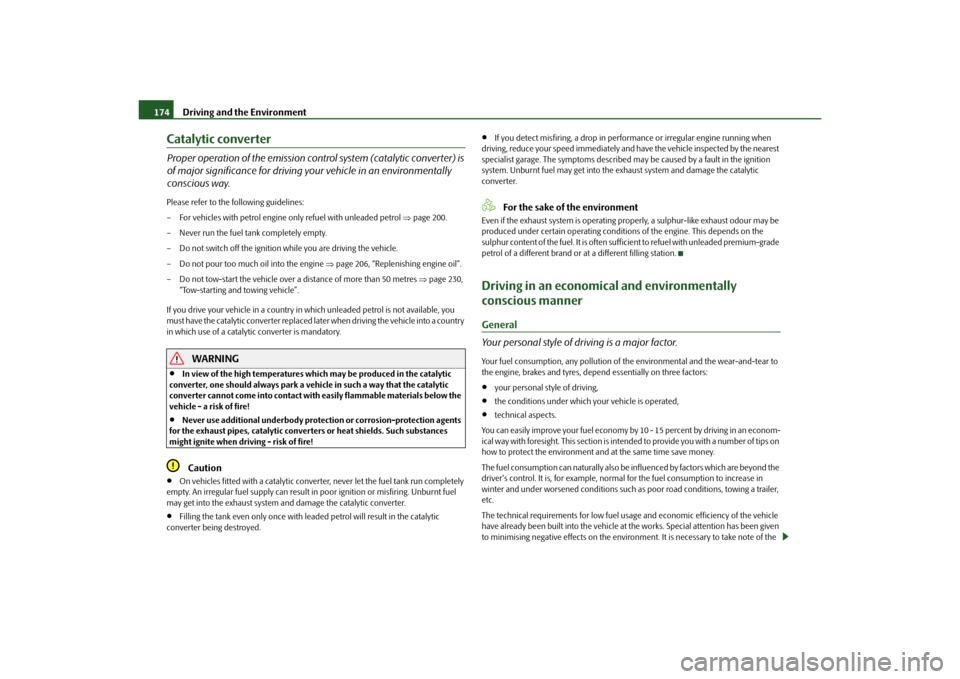
Driving and the Environment
174
Catalytic converterProper operation of the emission cont rol system (catalytic converter) is
of major significance for driving your vehicle in an environmentally
conscious way.Please refer to the following guidelines:
– For vehicles with petrol engine only refuel with unleaded petrol page 200.
– Never run the fuel tank completely empty.
– Do not switch off the ignition while you are driving the vehicle.
– Do not pour too much oil into the engine page 206, “Replenishing engine oil”.
– Do not tow-start the vehicle over a distance of more than 50 metres page 230,
“Tow-starting and towing vehicle”.
If you drive your vehicle in a country in which unleaded petrol is not available, you
must have the catalytic converter replaced la ter when driving the vehicle into a country
in which use of a catalyti c converter is mandatory.
WARNING
In view of the high temperatures which may be produced in the catalytic
converter, one should always park a vehicle in such a way that the catalytic
converter cannot come into contact with easily flammable materials below the
vehicle - a risk of fire!
Never use additional underbody protection or corrosion-protection agents
for the exhaust pipes, catalytic converters or heat shields. Such substances
might ignite when driving - risk of fire!Caution
On vehicles fitted with a catalytic converte r, never let the fuel tank run completely
empty. An irregular fuel supply can result in poor ignition or misfiring. Unburnt fuel
may get into the exhaust system and damage the cata lytic converter.
Filling the tank even only once with leaded petrol will result in the catalytic
converter being destroyed.
If you detect misfir ing, a drop in performance or irregular engine running when
driving, reduce your speed immediately and have the vehicle inspected by the nearest
specialist garage. The symptoms described ma y be caused by a fault in the ignition
system. Unburnt fuel may get into the exhaust system and damage the catalytic
converter.For the sake of the environment
Even if the exhaust system is operating pr operly, a sulphur-like exhaust odour may be
produced under certain oper ating conditions of the engine. This depends on the
sulphur content of the fuel. It is often sufficient to refuel with unleaded premium-grade
petrol of a different brand or at a different filling station.Driving in an economical and environmentally
conscious mannerGeneral
Your personal style of driving is a major factor.Your fuel consumption, any pollution of the environmental and the wear-and-tear to
the engine, brakes and tyres, depend essentially on three factors:
your personal style of driving,
the conditions under which your vehicle is operated,
technical aspects.
You can easily improve your fuel economy by 10 - 15 percent by driving in an econom-
ical way with foresight. This section is intended to provide you with a number of tips on
how to protect the environment and at the same time save money.
The fuel consumption can naturally also be influenced by factors which are beyond the
driver's control. It is, for example, normal for the fuel consumption to increase in
winter and under worsened cond itions such as poor road conditions, towing a trailer,
etc.
The technical requirements for low fuel usage and economic efficiency of the vehicle
have already been built into the vehicle at the works. Special attention has been given
to minimising negative effects on the environment. It is necessary to take note of the
s2ug.6.book Page 174 Friday, April 9, 2010 2:24 PM
Page 180 of 271
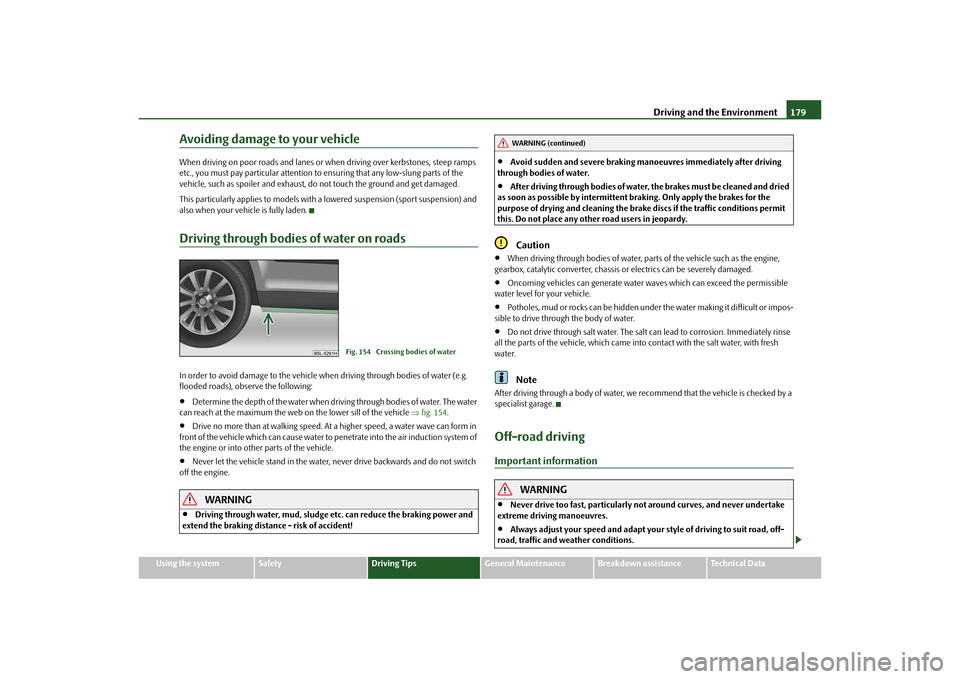
Driving and the Environment179
Using the system
Safety
Driving Tips
General Maintenance
Breakdown assistance
Technical Data
Avoiding damage to your vehicleWhen driving on poor roads and lanes or when driving over kerbstones, steep ramps
etc., you must pay particular attention to ensuring that any low-slung parts of the
vehicle, such as spoiler and exhaust, do not touch the ground and get damaged.
This particularly applies to models with a lowered suspen sion (sport suspension) and
also when your vehicle is fully laden.Driving through bodies of water on roadsIn order to avoid damage to the vehicle wh en driving through bodies of water (e.g.
flooded roads), observe the following:
Determine the depth of the water when driv ing through bodies of water. The water
can reach at the maximum the web on the lower sill of the vehicle fig. 154 .
Drive no more than at walking speed. At a higher speed, a water wave can form in
front of the vehicle which can cause water to penetrate into the air induction system of
the engine or into other parts of the vehicle.
Never let the vehicle stand in the water, never drive backwards and do not switch
off the engine.
WARNING
Driving through water, mud, sludge etc. can reduce the braking power and
extend the braking distance - risk of accident!
Avoid sudden and severe braking manoeuvres immediately after driving
through bodies of water.
After driving through bodies of water, the brakes must be cleaned and dried
as soon as possible by intermittent braking. Only apply the brakes for the
purpose of drying and cleaning the brake discs if the traffic conditions permit
this. Do not place any other road users in jeopardy.Caution
When driving through bodies of water, pa rts of the vehicle such as the engine,
gearbox, catalytic converter, chassis or electrics can be severely damaged.
Oncoming vehicles can generate water waves which ca n exceed the permissible
water level for your vehicle.
Potholes, mud or rocks can be hidden under the water making it difficult or impos-
sible to drive through the body of water.
Do not drive through salt water. The salt can lead to corrosion. Immediately rinse
all the parts of the vehicle, which came into contact with the salt water, with fresh
water.Note
After driving through a body of water, we recommend that the vehicle is checked by a
specialist garage.Off-road drivingImportant information
WARNING
Never drive too fast, particularly not around curves, and never undertake
extreme driving manoeuvres.
Always adjust your speed and adapt your style of driving to suit road, off-
road, traffic and weather conditions.
Fig. 154 Crossing bodies of water
WARNING (continued)
s2ug.6.book Page 179 Friday, April 9, 2010 2:24 PM
Page 181 of 271
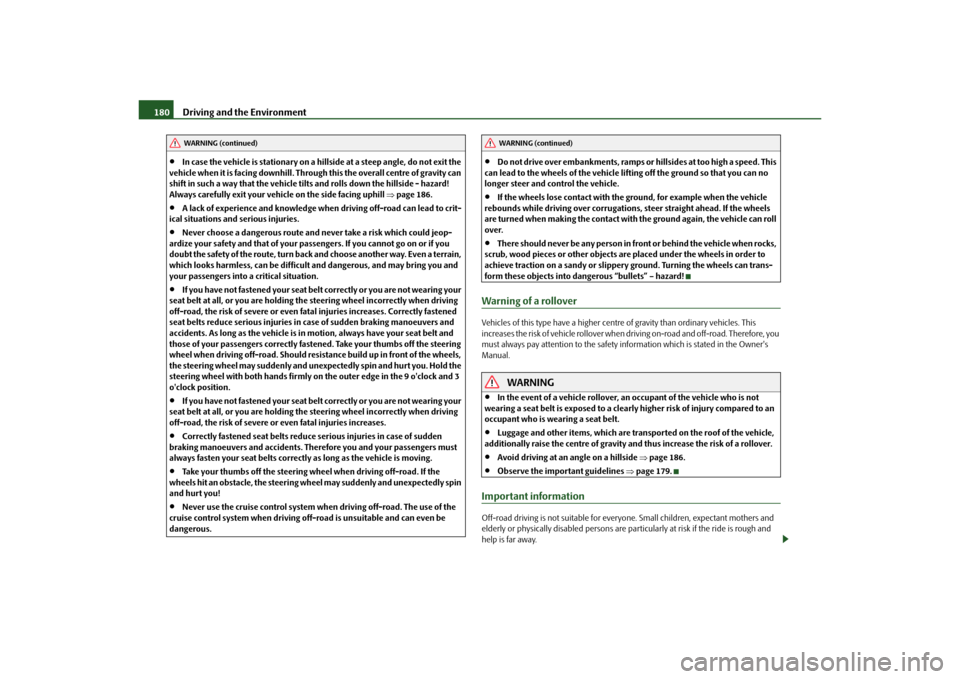
Driving and the Environment
180
In case the vehicle is stationary on a hillside at a steep angl e, do not exit the
vehicle when it is facing downhill. Throug h this the overall centre of gravity can
shift in such a way that the vehicle tilts and rolls down the hillside - hazard!
Always carefully exit your vehicle on the side facing uphill page 186.
A lack of experience and knowledge when driving off-road can lead to crit-
ical situations an d serious injuries.
Never choose a dangerous route and never take a risk which could jeop-
ardize your safety and that of your passengers. If you cannot go on or if you
doubt the safety of the route, turn back and choose another way. Even a terrain,
which looks harmless, can be difficult and dangerous, and may bring you and
your passengers into a critical situation.
If you have not fastened your seat belt correctly or you are not wearing your
seat belt at all, or you are holding the steering wheel incorrectly when driving
off-road, the risk of severe or even fata l injuries increases. Correctly fastened
seat belts reduce serious injuries in case of sudden braking manoeuvers and
accidents. As long as the vehicle is in motion, always have your seat belt and
those of your passen gers correctly fastened. Take yo ur thumbs off the steering
wheel when driving off-road. Should resist ance build up in front of the wheels,
the steering wheel may suddenly and unexpect edly spin and hur t you. Hold the
steering wheel with both hands firmly on the outer edge in the 9 o'clock and 3
o'clock position.
If you have not fastened your seat belt correctly or you are not wearing your
seat belt at all, or you are holding the steering wheel incorrectly when driving
off-road, the risk of severe or even fatal injuries increases.
Correctly fastened seat belts reduce serious injuries in case of sudden
braking manoeuvers and accidents. Th erefore you and your passengers must
always fasten your seat belts correctl y as long as the vehicle is moving.
Take your thumbs off the steering wh eel when driving off-road. If the
wheels hit an obstac le, the steering wheel may suddenly and unexpectedly spin
and hurt you!
Never use the cruise control system wh en driving off-road. The use of the
cruise control system when driving of f-road is unsuitable and can even be
dangerous.
Do not drive over embankments, ramps or hillsides at too high a speed. This
can lead to the wheels of the vehicle lifting off the ground so that you can no
longer steer and control the vehicle.
If the wheels lose contact with the ground, for example when the vehicle
rebounds while driving over corrugations, steer straight ahead. If the wheels
are turned when making the contact with the ground again, the vehicle can roll
over.
There should never be any person in front or behind the vehicle when rocks,
scrub, wood pieces or other objects ar e placed under the wheels in order to
achieve traction on a sandy or slippery ground. Turning the wheels can trans-
form these objects into dangerous “bullets” – hazard!
Warning of a rolloverVehicles of this type have a higher centre of gravity than ordinary vehicles. This
increases the risk of vehicle rollover when driving on-road and off-road. Therefore, you
must always pay attention to the safety information which is stated in the Owner's
Manual.
WARNING
In the event of a vehicle rollover, an occupant of the vehicle who is not
wearing a seat belt is exposed to a clearly higher risk of injury compared to an
occupant who is wearing a seat belt.
Luggage and other items, which are transported on the roof of the vehicle,
additionally raise the centre of gravity and thus increase the risk of a rollover.
Avoid driving at an angle on a hillside page 186.
Observe the important guidelines page 179.
Important informationOff-road driving is not suitable for everyone. Small children, expectant mothers and
elderly or physically di sabled persons are particularly at risk if the ride is rough and
help is far away.
WARNING (continued)
WARNING (continued)
s2ug.6.book Page 180 Friday, April 9, 2010 2:24 PM
Page 182 of 271

Driving and the Environment181
Using the system
Safety
Driving Tips
General Maintenance
Breakdown assistance
Technical Data
The first priority
should always be safety.
Never overestimate your own capabilities and never underestimate the difficulties of
driving off-road.
We cannot discuss all the possible driving situations in this manual, because there are
so many types of terrains which may hide different risks and dangers. The examples
listed in this manual are general rules for safe off-road driving. It is however not
possible to predict if these rules are valid for all the situations which may occur. Before
driving through unknown terrain, it is ther efore important that you know what lies
ahead of you. This way you can estima te any possible danger in advance.
For the sake of the environment
When driving off-road, show respect and appreciation for the environment and its
preservation for future generations.Before driving off-road for the first timeBefore driving off-road, we recommend that you take part in an Off-road driver
training course. This is especial l y i m p o r t a n t i f y o u h a v e l i t t l e o r n o e x p e r i e n c e o f d r i v i n g
off-road. In a driver training course, you learn how to use th e vehicle in many different
off-road situations and how to handle the vehicle safely when driving through rough
terrain.
Driving off-road requires entirely different skills from the driver and a very different
behaviour than driving on the road. Your pers onal safety and that of your passengers
depend on you, your capabili ties and your cautiousness.
Do not drive off-road where it is not suitable for your vehicle or where the demands
on you are too high. Although your vehicle can handle off-road driving, it is not
designed for travels with expedition characteristics.
Before each journey off-road, make sure that the vehicle is appropriately equipped for
the planned journey page 182. The standard equipmen t of your vehicle may not be
sufficient for your journey. With the standard tyres you can drive with your off-road
vehicle through easy terrain, such as flat forest roads, meadows and fields. Please note
however, that driving the vehicle on a diffic ult, muddy and sandy ground is restricted
and that the traction of the standard tyres is reduced when driving off-road. If you have
planned prolonged or difficul t off-road trips, we recommend that you equip your
vehicle with suitable off-road tyres.
WARNING
Observe the important guidelines page 179.Rules of conduct for responsible off-road drivingObserve the valid national legal requirements when driving off-road.Explanation of technical termsFig. 155 Embankment angle / slope angle
Fig. 156 Ground clearance / ramp angleThe technical data page 245, “Angle (in degree)” refer to ideal conditions. These
values may differ depending on the load and composition of the soil and the environ-
ment. The driver is responsible to decide whether a vehicle can overcome a certain
situation.
s2ug.6.book Page 181 Friday, April 9, 2010 2:24 PM
Page 183 of 271
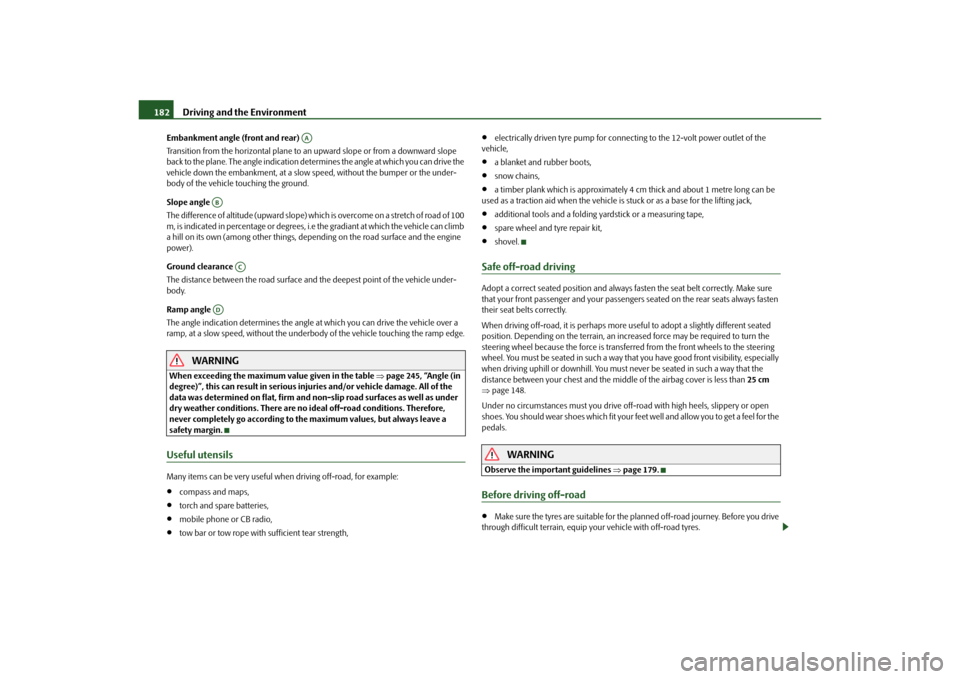
Driving and the Environment
182
Embankment angle (front and rear)
Transition from the horizontal plane to an upward slope or from a downward slope
back to the plane. The angle indication determines the angle at which you can drive the
vehicle down the embankment, at a slow speed, without the bumper or the under-
body of the vehicle touching the ground.
Slope angle
The difference of altitude (upward slope) which is overcome on a stretch of road of 100
m, is indicated in percentage or degrees, i. e the gradiant at which the vehicle can climb
a hill on its own (among other things, depe nding on the road surface and the engine
power).
Ground clearance
The distance between the road surface and the deepest point of the vehicle under-
body.
Ramp angle
The angle indication determines the angle at which you can drive the vehicle over a
ramp, at a slow speed, without the underbody of the vehicle touching the ramp edge.
WARNING
When exceeding the maximum value given in the table page 245, “Angle (in
degree)”, this can result in serious inju ries and/or vehicle damage. All of the
data was determined on flat, firm and no n-slip road surfaces as well as under
dry weather conditions. There are no id eal off-road conditions. Therefore,
never completely go according to the maximum values, but always leave a
safety margin.Useful utensilsMany items can be very useful wh en driving off-road, for example:
compass and maps,
torch and spare batteries,
mobile phone or CB radio,
tow bar or tow rope with sufficient tear strength,
electrically driven tyre pump for connect ing to the 12-volt power outlet of the
vehicle,
a blanket and rubber boots,
snow chains,
a timber plank which is approximately 4 cm thick and about 1 metre long can be
used as a traction aid when the vehicle is stuck or as a base for the lifting jack,
additional tools and a folding yardstick or a measuring tape,
spare wheel and tyre repair kit,
shovel.
Safe off-road drivingAdopt a correct seated position and always fa sten the seat belt correctly. Make sure
that your front passenger and your passengers seated on the rear seats always fasten
their seat belts correctly.
When driving off-road, it is perhaps more useful to adopt a slightly different seated
position. Depending on the terrain, an incr eased force may be required to turn the
steering wheel because the force is transferred from the front wheels to the steering
wheel. You must be seated in such a way that you have good front visibility, especially
when driving uphill or downhill. You must never be seated in such a way that the
distance between your chest and the midd le of the airbag cover is less than 25 cm
page 148.
Under no circumstances must you drive off-ro ad with high heels, slippery or open
shoes. You should wear shoes which fit your feet well and allow you to get a feel for the
pedals.
WARNING
Observe the important guidelines page 179.Before driving off-road
Make sure the tyres are suitable for the pl anned off-road journey. Be fore you dri ve
through difficult terrain, equip yo ur vehicle with off-road tyres.
AA
AB
AC
AD
s2ug.6.book Page 182 Friday, April 9, 2010 2:24 PM